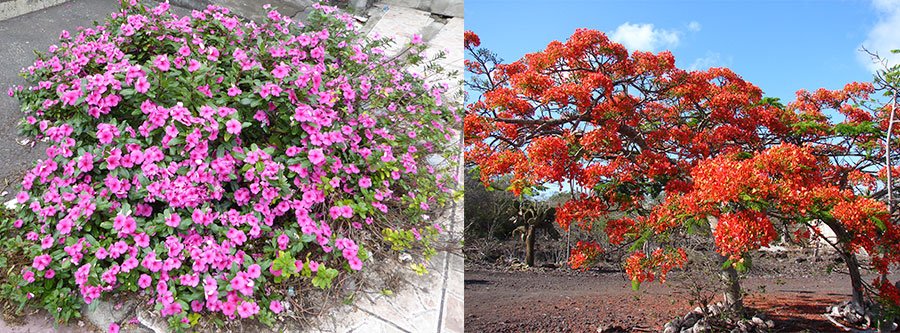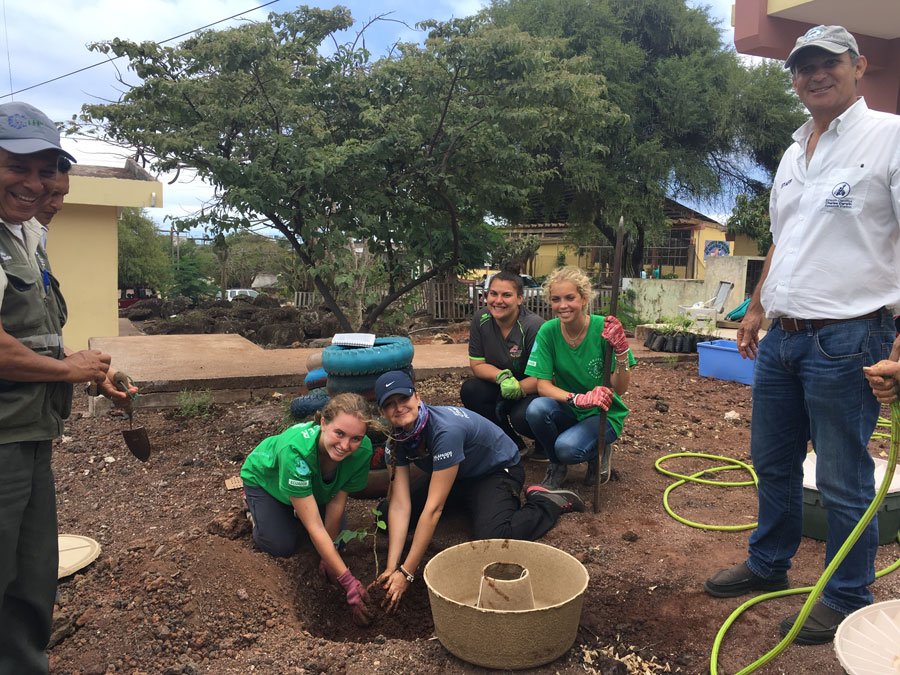The ecological gardens established Galápagos Verde 2050 (GV2050) of the Charles Darwin Foundation at various points in the islands populated in the archipelago, are not just another green space. Working as a team allows us to create beautiful and well-tendered gardens with local students. The students are able to not only care but also learn about the endemic and native plants of their islands and become familiar with the flora of the archipelago.
We believe that humans can live in harmony with the natural landscapes of Galapagos. However, to ensure that these beautiful islands are preserved beyond the work of projects such as Galápagos Verde 2050, we must sow in the minds of young people the seeds of environmental stewardship. For this reason, the Galápagos Verde 2050 project of the Charles Darwin Foundation works on urban ecological restoration and creates native gardens in collaboration with local schools and locals institutions (P. Jaramillo et al., 2015). This ensures that the future conservation of Galápagos will not only be the responsibility of scientists or park rangers but that the entire community will work daily to take care of this beautiful place.
When I arrived to the Galapagos from Spain as a volunteer, everything I saw seemed different to me; I felt so fortunate knowing that I was working on the conservation of such a unique ecosystem. As a biology student, being able to come to the archipelago was more than a dream. Every day I spend here is like being in a new world—surrounded by plants that are nothing like I have ever seen before and by animals that sometimes look like the “Godzilla monster”.
After almost 2 years on these "Enchanted Islands", I have seen the local population show concern for the conservation of nature, with a large number of murals around the town dedicated to the biodiversity of Galapagos and public events that support conservation in the Archipelago.
The introduction of invasive species is one of the main problems that threaten the biodiversity of the Galapagos (P. Jaramillo, 1998; P. Jaramillo & Tapia, 1999; Traveset & Santamaría, 2004). But in the Galapagos, introduced plants are often used in local gardens. In addition to not providing any cultural significance, these plants are invasive and threaten the protected areas of the Galapagos by growing uncontrollably and displacing the insular flora. However, it is quite common to see Catharanthus roseus, better known as "chavelas”, in gardens around urban populations. It is an introduced species that, although it looks pretty, its flowers, leaves, stems, and seeds have adverse effects and its high toxicity does not make it advisable for human consumption despite being used as a medicinal(Nayak & Pinto Pereira 2006). Despite being evaluated as an insecticide, effects on host larvae and more (Prajapati, Tripathi, Khanuja, & Kumar, 2003), in Galapagos toxic effects have been observed in some endemic and native pollinator that interact with this species (Patricia Jaramillo’s personal observation).

The key to combating this problem in urban areas is: education. Within the ecological restoration component of the project, GV2050 works in urban areas using three water saving technologies (Groasis, Cocoon and Hydrogel), creating ecological gardens with the community in order to involve and educate the archipelago’s local and visiting populations of the need to have green areas with endemic and native plants. At present, we have created 17 ecological gardens on the islands of Santa Cruz, Floreana, and San Cristóbal, with a total of 797 endemic and native plants planted for people to enjoy (Menéndez & Jaramillo, 2015).
As the ecologist Baba Dioum said in 1968: "In the end, we will preserve only what we love; we will love only what we understand, and we will understand only what we are taught".
Instilling values of conservation, education and sustainable life to the more than 30,000 permanent residents of the Galapagos are a goal for Galápagos Verde 2050 (P. Jaramillo, Tapia, Romero, & Gibbs, 2017). Beyond the GV2050 project and its timeline, the continued conservation of the archipelago’s flora is ultimately in the hands of its inhabitants. This is the main reason why we work with students, creating ecological gardens, giving presentations, dressing up as endemic cacti and educating the children about the archipelago's own species.

These gardens also help to restore the ecosystem. An increased presence of animals and insects that feed on nectar or rest on branches increase seed dispersal and improve pollination. When we increase the green area around built-up areas, we are creating a refuge for the biodiversity of the place and also improve our own quality of life.
If you think about it, there are so many organisms that can exist just in your own backyard. It is estimated that 90% of flowering plants around the world depend on pollination to reproduce, so planting native species in our garden is an easy method of promoting native pollination (Atkinson, Guézou, & Jaramillo, 2017).
At some hotels, such as Pikaia Lodge Galapagos in the highland of Santa Cruz island and various public and private institutions, we have created a garden so that tourists that visit this hotel have more knowledge about the species they can see. Through signs that identify each species, we provide information so that visitors can leave the islands knowing more about the flora.

At the end of 2018, the Galápagos Verde 2050 team, was in the Humboldt School on San Cristóbal, to begin restoration of the urban areas of this island. We worked with international baccalaureate students, a group of young park-rangers, students and teachers of the institution to create ecological gardens, which students will continue to care. Educational institutions play a fundamental role in creating positive environmental attitudes and promoting respect for the nature that surrounds their students; and what better way to learn than by doing it themselves? The planting of endemic and native plants allows young people to have contact with the flora of their region and to appreciate their spaces, becoming aware of the importance of their uses, as well as the implication of their permanence or disappearance from an ecosystem.
Before starting, we worked together to clean the area that would later become our garden. Through this, we explained to the children the value of not littering and that we have to respect the environment where plants and animals live. After that, we explained how water-saving technologies work, and finally planted the ecological garden for their school.

In April 2019, we were working in a special and wonderful place together with children from the Galápagos Special Education Unit. When we showed them the hydrogel or they were digging in the soil to plant the seedling, they looked so excited, and at the end of the activity, they had big smiles and gave us hugs. This type of outdoor activities favors their learning as the stimuli come from the environment and can see step by step changes in nature. Definitely, for the team it was the best gift, to be able to work with these students and see the happiness on their faces.

To complement the creation of these ecological gardens in urban areas, the Charles Darwin Foundation through the GV2050 project, created the second version of the book "Siémbrame en tu jardín" (Atkinson et al., 2017) https://www.

Our generation has the potential to reverse the degradation of the ecosystems, therefore we must seize the opportunity to create these gardens. We must raise awareness in younger generations so that we can have a better tomorrow for Galapagos and for the world because ecological conservation is essential for your future.
GV2050 project is implemented in collaboration with the Charles Darwin Foundation and Galapagos National Park Directorate. The project is financially viable thanks to the support of the COmON Foundation, The Leona M and Harry B. Helmsley Charitable Trust and the BESS Forest Club. We would like to also extend our thanks to ABG, ECOGAL, Municipality, Schools, MAG for the support given to the work of GV2050 during the trip and supporting conservation in the Galapagos, and to Patricia Jaramillo Díaz and Esme Plunkett for their helpful insights, edition and translation of this piece.

Bibliography:
- Atkinson, R., Guézou, A., & Jaramillo, P. (2017). Siémbrame en tu Jardín - Kanpa sisapampapi tarpuway - Plant me in your Garden. Jardines nativos para la conservacion de Galapagos - Galapagos suyu kuskata kamankapak sisapampakuna - native gardens for the conservation of Galapagos. Segunda edición. Fundación Charles Darwin: Islas Galápagos-Ecuador.
- Jaramillo, P. (1998). Impact of human activities on the Native plant life in Galápagos National Park Galápagos Report 1998-1999 (pp. 2-8).
- Jaramillo, P., Guézou, A., Mauchamp, A., & Tye, A. (2017). CDF Checklist of Galapagos Flowering Plants - FCD Lista de especies de Plantas con flores de Galápagos. In: Bungartz, F., Herrera, H.,
- Jaramillo, P., Tirado, N., Jímenez-Uzcátegui, G., Ruiz, D., Guézou, A. & Ziemmeck, F. (eds.). Charles Darwin Foundation Galapagos Species Checklist - Lista de Especies de Galápagos de la Fundación Charles Darwin. Charles Darwin Foundation / Fundación Charles Darwin, Puerto Ayora, Galapagos: http://darwinfoundation.org/datazone/checklists/media/lists/download/2017Nov08_Jaramillo-Diaz_et_al_Galapagos_Magnoliophyta_Checklist.pdf updated 08 Nov 2017.
- Jaramillo, P., Lorenz, S., Ortiz, G., Cueva, P., Jiménez, E., Ortiz, J., . . . Tapia, W. (2015). Galapagos Verde 2050: An opportunity to restore degraded ecosystems and promote sustainable agriculture in the Archipelago. In L. Cayot, D. Cruz & R. Knab (Eds.), GALAPAGOS REPORT 2013 - 2014 (pp. 133-143). Biodiversity and Ecosystem Restoration: GNPD, GCREG, CDF, and GC https://www.
researchgate.net/publication/ 281842310_Galapagos_Verde_ 2050_An_opportunity_to_ restore_degraded_ecosystems_ and_promote_sustainable_ agriculture_in_the_Archipelago. - Jaramillo, P., & Tapia, W. (1999). Las Especies Introducidas Agresivas en las Islas Galápagos y las medidas tomadas para su control. El Parquero. 40 años del Parque Nacional Galápagos(Edición Especial), 14-16.
- Jaramillo, P., Tapia, W., Romero, L., & Gibbs, J. (2017). Galápagos Verde 2050: Restauración ecológica de ecosistemas degradados y agricultura sostenible utilizando tecnologías ahorradoras de agua. Estación Científica Charles Darwin. Fundación Charles Darwin.
- Menéndez, Y., & Jaramillo, P. (2015). Aplicación Android y plataforma vistual del proyecto Galápagos Verde 2050.
- Nayak, B. S., & Pinto Pereira , L. (2006). Catharanthus roseus flower extract has wound-healing activity in Sprague Dawley rats. BMC Complementary and Alternative Medicine, 6(1), 41. doi: https://doi.org/10.1186/1472-6882-6-41
- Prajapati, V., Tripathi, A. K., Khanuja, S. P. S., & Kumar, S. (2003). Anti-insect Screening of Medicinal Plants from Kukrail Forest, Lucknow, India. Pharmaceutical Biology, 41(3), 166-170. doi: 10.1076/phbi.41.3.166.15092
- Traveset, A., & Santamaría, L. (2004). Alteración de mutualismos planta-animal debido a la introducción de especies exóticas en ecosistemas insulares. Ecología Insular, 251-276.





